You are here
Amateur Radio News
ARRL Southeastern Division Vice Director Jeff Beals, WA4AW, SK
The Vice Director of the ARRL Southeastern Division, Jeffrey J. “Jeff” Beals, WA4AW, has become a Silent Key. He died on July 20, 2024. Beals, who was born in 1951, devoted a lifetime of service to amateur radio, having served in many local clubs, the ARRL Field Organization, and on the ARRL Board of Directors. He was also elected Vice President of the Quarter Century Wireless Association (QCWA...
ANS-203 AMSAT News Service Weekly Bulletins
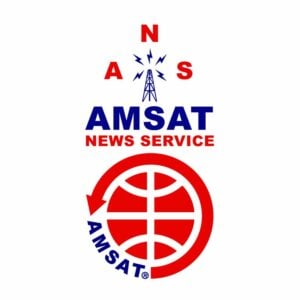
July 18, 2024
In this edition:
- AMSAT Board of Directors Election Underway
- AMSAT Mail Alias Service to End August 31, 2024
- Tevel Satellites Nearing Re-Entry
- AMSAT-OSCAR 7 in Continuous Sunlight
- Changes to AMSAT TLE Distribution for July 19, 2024
- ARISS News
- Upcoming Satellite Operations
- AMSAT Ambassador Activities
- Satellite Shorts From All Over
The AMSAT News Service bulletins are a free, weekly news and information service of AMSAT, The Radio Amateur Satellite Corporation. ANS publishes news related to Amateur Radio in Space including reports on the activities of a worldwide group of Amateur Radio operators who share an active interest in designing, building, launching and communicating through analog and digital Amateur Radio satellites.
The news feed on https://www.amsat.org publishes news of Amateur Radio in Space as soon as our volunteers can post it.
Please send any amateur satellite news or reports to: ans-editor [at] amsat.org
You can sign up for free e-mail delivery of the AMSAT News Service Bulletins via the ANS List; to join this list see: https://mailman.amsat.org/postorius/lists/ans.amsat.org/
Save the Date! Symposium 2024 Photo by Robert DuBois
Photo by Robert DuBois
Mark your calendar now for the 2024 AMSAT Symposium,
October 25-27, 2024 at the Doubletree by Hilton Tampa Rocky Point Waterfront in Tampa, Florida!
Watch for announcements concerning further details as plans are formulated. AMSAT Board of Directors Election UnderwayThe nomination period for the 2024 AMSAT Board of Directors Election ended on June 15th. The following candidates have been duly nominated:
- Mark Hammond, N8MH
- Frank Karnauskas, N1UW
- Bruce Paige, KK5DO
- Paul Stoetzer, N8HM
- Douglas Tabor, N6UA
As three seats on the Board of Directors are up for election this year, the three candidates receiving the largest number of votes shall be declared elected to the seats. The two candidates receiving the next largest number of votes shall be declared First Alternate and Second Alternate, respectively.
The voting process is now underway. AMSAT members can find candidate statements and electronic voting information on AMSAT’s Wild Apricot Membership Portal.
The voting period will conclude on September 15th and results will be announced no later than September 30th.
[ANS thanks Jeff Davis, KE9V, AMSAT Secretary for the above information]
AMSAT Mail Alias Service to End August 31, 2024A long-standing member service, the AMSAT Mail Alias Service is scheduled to end on August 31, 2024. A mail alias on AMSAT.ORG permitted people to send an email to members without knowing their actual internet email address. They just needed to know their amateur radio callsign.
Unfortunately, the unchecked rise in domain name hacking and email account high-jacking has made it impossible to sustain this service at a cost-effective level. The number of callsign@amsat.org email accounts that had been hijacked and converted to zombie spam accounts over the years had led many internet service providers and gateway centers to ban all @amsat.org email addresses, including those business accounts of AMSAT officers and officials. The tireless efforts of AMSAT’s all volunteer IT staff has worked for years to repair much of the damage, but AMSAT still get complaints from members who are not getting their personal emails, ANS bulletins or AMSAT-BB posts because of persistent delivery problems.
It has come to the point where the AMSAT volunteer IT staff can no longer keep up with the maintenance requirements to keep the alias mail list clean and to work with email gateways to remove blocks. And, after considerable investigation into alternative paid email services, AMSAT leadership decided that the money required to keep an email alias system alive would be better spent on building and flying satellites for its members.
Persons using the Mail Alias Service should begin to migrate to different email accounts so they do not lose receipt of personal emails, AMSAT News Service Weekly Bulletins, AMSAT-BB posts, or official messages from AMSAT itself. Members are especially asked to make sure they are NOT using a callsign@amsat.org as their registered email address in the AMSAT membership portal. Members can easily change their registered member email address by logging into the portal and updating their profile.
[ANS thanks AMSAT for the above information]
Tevel Satellites Nearing Re-Entry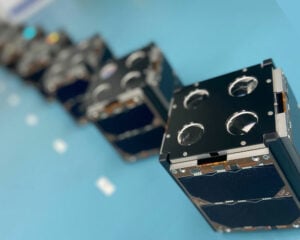
The Tevel series of satellites is approaching re-entry, with Tevel-5 already re-entering on July 18th.
The Tevel mission consists of 8 satellites developed by the Herzliya Science Center in Israel, each carrying an FM transponder. The satellites were built by 8 schools in different parts of Israel and launched in January 2022 on the SpaceX Falcon 9 Transporter-3 mission.
A number of other satellites with amateur radio payloads are also re-entering shortly. A list of satellites approaching re-entry can be found at http://lu7aa.org/decay.asp
[ANS thanks Herzliya Science Center, AMSAT Argentina, and LU7AA for the above information]
The 2024 Coins Are Here Now!Help Support GOLF and Fox Plus.
Join the AMSAT President’s Club today!
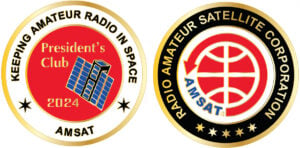
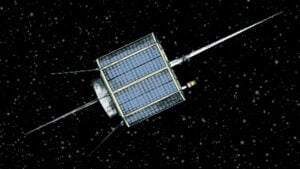
AMSAT-OSCAR 7, soon to celebrate its 50th birthday on November 15, 2024, is now in a period of continuous sunlight through May 22, 2027.
While in continuous sunlight, the satellite’s internal timer is expected to switch between the two transponders – Mode A (29 MHz downlink and 145 MHz uplink) and Mode B (145 MHz downlink and 29 MHz uplink) every 24 hours.
Post reports and check current status on the AMSAT Live OSCAR Satellite Status Page. After a few days in continuous sunlight, it should be possible to determine the actual or approximate time the satellite switches.
[ANS thanks AMSAT and EA1PA for the above information]
Changes to AMSAT TLE Distribution for July 19, 2024Two Line Elements or TLEs, often referred to as Keplerian elements or keps in the amateur community, are the inputs to the SGP4 standard mathematical model of spacecraft orbits used by most amateur tracking programs. Weekly updates are completely adequate for most amateur satellites. TLE bulletin files are updated Thursday evenings around 2300 UTC, or more frequently if new high interest satellites are launched. More information may be found at https://www.amsat.org/keplerian-elements-resources/
The following satellites have been removed from this week’s AMSAT TLE distribution:
MESAT1 remains on this distribution. No signals have been detected from any other amateur spacecraft launched as part of NASA’s ELaNa 43 mission.
ELaNa 43 OBJECT A NORAD Cat ID 60203 No amateur signal detected
ELaNa 43 OBJECT B NORAD Cat ID 60204 No amateur signal detected
ELaNa 43 OBJECT C NORAD Cat ID 60205 No amateur signal detected
ELaNa 43 OBJECT D NORAD Cat ID 60206 No amateur signal detected
ELaNa 43 OBJECT E NORAD Cat ID 60207 No amateur signal detected
ELaNa 43 OBJECT F NORAD Cat ID 60208 No amateur signal detected
ELaNa 43 OBJECT H NORAD Cat ID 60210 No amateur signal detected
Zhou Enlai NORAD Cat ID 43156 Decayed from orbit on or about 17 July 2024
TEVEL-5 NORAD Cat ID 50998 Decayed from orbit on or about 18 July 2024
The following satellites have been added to this week’s AMSAT TLE distribution:
GRBBeta NORAD Cat ID 60236 IARU coordinated downlinks on 145.935 MHz, 436.785 MHz and 2405.000 MHz
ROBUSTA-3A NORAD Cat ID 60241 IARU coordinated 9k6 GMSK with AX.25 downlink on 436.750 MHz
Thanks to Nico PA0DLO for identifying the two new spacecraft.
[ANS thanks Joe Fitzgerald, KM1P, AMSAT Orbital Elements Manager, for the above information]
Need new satellite antennas?Purchase an M2 LEO-Pack from the AMSAT Store! When you purchase through AMSAT, a portion of the proceeds goes towards Keeping Amateur Radio in Space.

Amateurs and others around the world may listen in on contacts between amateurs operating in schools and allowing students to interact with astronauts and cosmonauts aboard the International Space Station. The downlink frequency on which to listen is 145.800 MHz worldwide.
Aznakaevsky district schools of the Republic of Tatarstan, Tatarstan Russia, direct via TBD
The ISS callsign is presently scheduled to be RSØISS
The scheduled crewmember is Aleksandr Grebyonkin RZ3DSE
The ARISS mentor is RV3DR
Contact is go for Sat 2024-07-27 13:45 UTC
Arizona Science Center, Phoenix, AZ, telebridge via AB1OC
The ISS callsign is presently scheduled to be NA1SS
The scheduled crewmember is Matthew Dominick KCØTOR
The ARISS mentor is K4RGK
Contact is go: Sat 2024-07-27 18:24:08 UTC 41 deg
As always, if there is an EVA, a docking, or an undocking; the ARISS radios are turned off as part of the safety protocol.
The crossband repeater continues to be active (145.990 MHz up {PL 67} & 437.800 MHz down), If any crewmember is so inclined, all they have to do is pick up the microphone, raise the volume up, and talk on the crossband repeater. So give a listen, you just never know.
Note, all times are approximate. It is recommended that you do your own orbital prediction or start listening about 10 minutes before the listed time.
The latest information on the operation mode can be found at https://www.ariss.org/current-status-of-iss-stations.html
The latest list of frequencies in use can be found at https://www.ariss.org/contact-the-iss.html
[ANS thanks Charlie Sufana, AJ9N, one of the ARISS operation team mentors for the above information]
Upcoming Satellite OperationsA growing number of satellite rovers are currently engaged in sharing their grid square activations on https://hams.at. By visiting the website, you gain easy access to comprehensive information about the operators responsible for activating specific grid squares. Additionally, you have the ability to assess the match score between yourself and a particular rover for a given pass, while also being able to identify the upcoming satellite passes that are accessible from your location.
N8MR will be in EN57, with roves to EN67 from Aug 2 thru Aug 10. Icom 9700, Arrow and Alaskan (IO-117) antennas. Listening for Europe on linear eastern passes, at least two of these on CW. Can operate CW for NA ops, if anyone wants it. I can rove to EN56, only if needed. Posting passes to http://hams.at a day in advance. All QSOs to LoTW as N8MR.
[ANS thanks Ian Parsons, K5ZM, AMSAT Rover Page Manager, for the above information]
Want to fly the colors on your own grid expedition?Get an AMSAT car flag and other neat stuff from our Zazzle store!
25% of the purchase price of each product goes towards Keeping Amateur Radio in Space
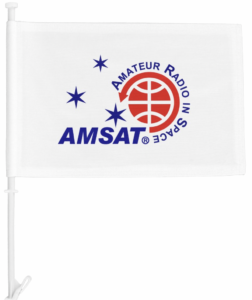
AMSAT Ambassadors provide presentations, demonstrate communicating through amateur satellites, and host information tables at club meetings, hamfests, conventions, maker faires, and other events.
AMSAT Ambassador Clint Bradford, K6LCS, says,
“Think a 75-minute presentation on “working the easy satellites” would be appropriate for your club or event? Let me know by emailing me at k6lcsclint (at) gmail (dot) com or calling me at 909-999-SATS (7287)!”
Clint has NEVER given the exact same show twice: EACH of the 150+ presentations so far has been customized/tailored to their audiences.
Scheduled Events2024 KARS / ARRL Idaho State Convention
August 3, 2024
Post Falls, ID
K7SYS
Huntsville Hamfest
August 17-18, 2024
Huntsville, AL
AMSAT Booth and Forum
N8DEU and W4FCL
Northeast HamXpostion
August 22-25, 2024
Best Western Royal Plaza Hotel & Trade Center
181 Boston Post Road W
Marlborough, MA 01752
Greater Louisville Hamfest
September 7, 2024
Shepherdsville, KY
AMSAT Forum and Information Table
W4FCL
Central Kentucky Hamfest
October 5, 2024
Lexington, KY
AMSAT and Educational Satellites Forum and Information Table
AI4SR and W4FCL
North Star Radio Convention
October 5, 2024
Hennepin Technical College (North Campus)
Brooklyn Park, Minn.
AMSAT Forum and Information Table
KØJM and ADØHJ
2024 AMSAT Space Symposium and Annual General Meeting
October 25-27, 2024
Doubletree by Hilton Tampa Rocky Point Waterfront
3050 N Rocky Point Dr W
Tampa, FL 33607
Stone Mountain Hamfest, ARRL State Convention
November 2-3, 2024
Stone Mountain, GA
K4RGK
[ANS thanks Bo Lowrey, W4FCL, Director – AMSAT Ambassador Program, for the above information]
Satellite Shorts from All Over+ XW-2B has recently returned to reliable service. XW-2B has an inverting linear transponder with an uplink of 435.090-435.110 MHz and a downlink of 145.730-145.750 MHz.
+ The May/June 2024 issue of The AMSAT Journal is now available to members on AMSAT’s Member Portal at https://launch.amsat.org/The_AMSAT_Journal
+ SpaceX’s Falcon 9 suffered a rare failure on July 11th when the upper stage “experienced an anomaly and was unable to complete its second burn,” trapping 20 Starlink satellites in an unusably low orbit. More information at https://spacenews.com/starlink-satellites-lost-on-falcon-9-upper-stage-failure/ (ANS thanks SpaceNews for the information)
Join AMSAT today at https://launch.amsat.org/
In addition to regular membership, AMSAT offers membership to:
- Societies (a recognized group, clubs or organization).
- Primary and secondary school students are eligible for membership at one-half the standard yearly rate.
- Post-secondary school students enrolled in at least half time status shall be eligible for the student rate for a maximum of 6 post-secondary years in this status.
- Memberships are available for annual and lifetime terms.
Contact info [at] amsat.org for additional membership information.
73 and remember to help Keep Amateur Radio in Space!
This week’s ANS Editor,
Paul Stoetzer, N8HM
n8hm [at] amsat.org
ANS is a service of AMSAT, the Radio Amateur Satellite Corporation, 712 H Street NE, Suite 1653, Washington, DC 20002
HamCon:Zion 2024
HamCon: Zion 2024, hosting the ARRL Rocky Mountain Division Convention, the Young Ladies Radio League 85th Convention, and the RV Radio Network’s 2024 Western Rally, was a success. The inaugural event, held in St. George, Utah, was well attended and many reported the facility and events were first rate.
ARRL National Instructor Gordon West, WB6NOA, was in the ARRL booth greeting visitors and ga...
The K7RA Solar Update
Big increase in solar activity this week, with average daily sunspot number rising from 129 to 215.9, and solar flux from 176.6 to 226.5.
Fourteen new sunspot groups emerged. Two were on July 11, one on July 12, three on July 13, one on July 14, two more on July 15, three more on July 16 and two more on July 17.
On Thursday (after the reporting week) the daily sunspot number was 276, the highes...
Get On the Air During VHF Contest Season
VHF contesting season is in full swing! Summer weather brings with it enhanced propagation. With good conditions, stations hundreds of miles away can be worked via tropospheric ducting, E-skip, and perhaps even meteor scatter. If you have an HF rig that includes 6 meters or VHF/UHF capability, you’ve got just the tools you need to take advantage of these enhancements! US amateurs of all license...
Voices from the ARRL Teachers Institute on Wireless Technology
The ARRL Teachers Institute on Wireless Technology continues to bring educators from around the country to ARRL Headquarters in Newington, Connecticut, to learn how to engage students with amateur radio and radio technology. The program helps tie wireless technology into science, technology, engineering, and mathematics (STEM) education.
In their own words:
This week, TI1, or the initial course o...
Randall Carlson, WB0JJX, Former Delaware Section Manager, Silent Key
Randall Carlson, WB0JJX, has become a Silent Key. He passed away June 7, 2024. Carlson was the Section Manager of the ARRL Delaware Section from December 1992 until 2005. He was originally licensed in the 1970s, according to his obituary. Carlson was 66 years old.
ARRL Announces Leadership Changes in the Hudson Division
ARRL Director Nomar Vizcarrondo, NP4H, who has represented the Hudson Division since March 2023, has stepped down, effective July 12, 2024, at 5 PM Eastern.
Vice Director Ed Wilson, N2XDD, will accede to the Director’s chair to complete the remainder of a 3-year term ending December 31, 2024. Wilson has served as Vice Director since June 2023. He has held ARRL Field Organization appointments as ...
ANS-196 AMSAT News Service Weekly Bulletins
In this edition:
- 2024 AMSAT Board of Directors Election
- Field Day Submissions Now Due
- Grace Papay, K8LG Named 2024 WA6ITF Memorial Amateur Radio Newsline Young Ham of the Year
- AMSAT TLE Dissemination Updates
- Updating Keps in SatPC32 – An Update from DK1TB
- NASA Discovers Strange Spectral Formations Cover LEO Orbits
- Changes to AMSAT-NA TLE Distribution for July 12, 2024
- ARISS News
- Upcoming Satellite Operations
- AMSAT Ambassador Events
- Satellite Shorts From All Over
The AMSAT News Service bulletins are a free, weekly news and information service of AMSAT, the Radio Amateur Satellite Corporation. ANS publishes news related to Amateur Radio in Space including reports on the activities of a worldwide group of Amateur Radio operators who share an active interest in designing, building, launching and communicating through analog and digital Amateur Radio satellites.
The news feed on http://www.amsat.org publishes news of Amateur Radio in Space as soon as our volunteers can post it.
Please send any amateur satellite news or reports to: ans-editor [at] amsat [dot] org.
You can sign up for free e-mail delivery of the AMSAT News Service Bulletins via the ANS List; to join this list see: https://mailman.amsat.org/postorius/lists/ans.amsat.org/
ANS-196 AMSAT News Service Weekly Bulletins
To: All RADIO AMATEURS
From: Radio Amateur Satellite Corporation
712 H Street NE, Suite 1653
Washington, DC 20002
DATE 2024 JUL 14
2024 AMSAT Board of Directors ElectionThe nomination period for the 2024 AMSAT Board of Directors Election ended on June 15th. The following candidates have been duly nominated:
- Mark Hammond, N8MH
- Frank Karnauskas, N1UW
- Bruce Paige, KK5DO
- Paul Stoetzer, N8HM
- Douglas Tabor, N6UA
As three seats on the Board of Directors are up for election this year, the three candidates receiving the largest number of votes shall be declared elected to the seats. The two candidates receiving the next largest number of votes shall be declared First Alternate and Second Alternate, respectively.
The voting process will be conducted via AMSAT’s Wild Apricot membership system and will commence on July 15th. Instructions for voting will be emailed to all members in good standing as of July 1st by July 15th.
The voting period shall conclude on September 15th and results will be announced not later than September 30th.
[ANS thanks Jeff Davis, KE9V, AMSAT Secretary for the above information.]
Field Day Submissions Now DueField Day is behind us and it is time to tally your contacts and submit the for AMSAT Field Day.
The Satellite Summary Sheet should be used for submission of the AMSAT Field Day competition and be received by Bruce Paige, KK5DO (e-mail) by 11:59 P.M. CDT, Monday, July 23, 2024. This year, Bruce is using the same due date as the ARRL. The only method for submitting your log is via e-mail to kk5do@amsat.org or kk5do@arrl.net. Bruce reports that he has not had a mail-in entry in a very long time.
If you need to download a summary sheet, it can be found at https://www.amsat.org/field-day/ or directly from his website https://www.amsatnet.com/2024fd.docx.
[ANS thanks Bruce Paige, KK5DO, AMSAT Director Contests and Awards, for the above information]
The 2024 AMSAT President’s Club coins are here now!
Help Support GOLF and Fox Plus
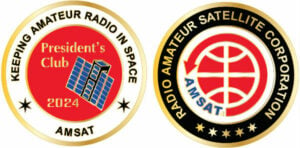
Join the AMSAT President’s Club today and help
Keep Amateur Radio in Space!
https://www.amsat.org/join-the-amsat-presidents-club/
Grace Papay, K8LG Named 2024 WA6ITF Memorial Amateur Radio Newsline Young Ham of the YearGrace Papay, K8LG, of Holland, Michigan, has been selected as the 2024 Bill Pasternak WA6ITF Memorial Amateur Radio Newsline Young Ham of the Year. Grace, 18, is the daughter of Doug Papay, K8DP, and Carrie Papay K8CLP.
Grace earned her Technician license in March 2021 and within a year achieved her Extra Class license, passing the test in March 2022.
She is a recent honors graduate of Holland Christian High School in her hometown, where she earned a varsity letter in the Unified Sports program.
Grace credited her father and her grandfather, John Papay, K8YSE, a well-known operator in the ham radio satellite community, for drawing her into the hobby.
“I got involved in amateur radio satellites,” Grace recalls. “I got on the air. And now it has turned into something from honoring my grandfather to a hobby I’m on every day and I love.” With support from her grandfather and father, she earned the DX Century Club certificate for contacts exclusively using satellites.
Grace attended Youth on the Air camps in Cincinnati in 2022 and Ottawa in 2023, where she says she was exposed to a variety of other amateur radio activities including balloon launches, slow-scan television and radio contesting.
She was part of the K3LR IOTA Dave Kalter Memorial Youth DX Adventure in 2023 and was a team member for the J62K St. Lucia DX contest operation in 2024. Grace is active on the HF bands and operates in the ARRL and CQ DX SSB and CW contests, ARRL Sweepstakes and CQ WPX, as well as Youth on the Air events.
For the past few years, Grace has been a regular presenter at the Youth Forum at Dayton Hamvention. She delivered a presentation on youth in contesting at the Contest University Forum at Dayton this year and assisted at the YOTA and AMSAT booths.
She is an active member of the Holland Amateur Radio Club, Grand Rapids Amateur Radio Association, West Chester Amateur Radio Association and the American Radio Relay League.
Grace received the Radio Club of America’s Young Achievers Award in 2023. She had an article on the “Next Generation of Contesters” published in the National Contest Journal (Nov/Dec 2023). A story she co-wrote on YOTA Camp 2022 appeared in the August 2022 edition of CQ magazine.
Grace will be attending Cedarville University in Cedarville, Ohio this fall, where she will study electrical engineering. She says amateur radio played a major role in her choice of a major.
The YHOTY award will be presented to Grace during a ceremony at the Huntsville Hamfest on Saturday, Aug. 17, 2024 at the Von Braun Center in Huntsville, Alabama. Amateur Radio Newsline and Yaesu USA are primary sponsors of the award, along with Heil Sound Ltd. and Radiowavz Antenna Company.
The Young Ham of the Year Award was inaugurated by William Pasternak, WA6ITF, in 1986. Upon his passing in 2015, Bill’s name was added to the award as a memorial to his commitment to recognizing the accomplishments of young people to the Amateur Radio Service.
[ANS thanks Amateur Radio Newsline for the above information.]
AMSAT TLE Dissemination UpdatesAMSAT with help from its partner New England Sci-Tech prepares a bulletin of orbital elements during the first hour of the UTC day, and posts it to https://www.amsat.org/tle/daily-bulletin.txt as well as “bare” elements without the bulletin header and footer at https://www.amsat.org/tle/dailytle.txt. Other files and URLs with “nasa” and “ftp” in the URL are still maintained to support older software, but suggest organizations protocols that are no longer involved in TLE dissemination. Use of older filenames and URLs is deprecated and AMSAT does not promise to maintain them in perpetuity.
End users and software developers are encouraged to use the URLs above going forward. The files are available via HTTPS (preferred) as well as unencrypted HTTP for legacy software.
[ANS thanks Joe Fitzgerald, KM1P, AMSAT Orbital Elements Manager/IT Team for the above information.]
Need new satellite antennas?
Purchase M2 LEO-Packs from the AMSAT Store.

When you purchase through AMSAT, a portion of the proceeds goes towards
Keeping Amateur Radio in Space.
https://amsat.org/product-category/hardware/
Updating Keps in SatPC32 – An Update from DK1TBErich Eichmann, DK1TB, SatPC32 author offers this update:
“The SatPC32 Update Keps feature doesn’t work with https links for TLE files. That would require changes of the source code and maybe requires a new Delphi version for me. I will care about that but that will at least take time and at present I don’t have much time for the hobby.
“But all https websites can be accessed also with http. They are not “secure” sites but that is meaningless with websites that contain Keps. Therefore use http in the aux. file Celestrak.SQF for AMSAT and Celestrak TLE (Two Line Elements) files, as described by Charlie, AJ9N, see below. With that modification the Download Keps function works.
“Also, the https links can be accessed with your browser, of course. Enter the links into the address line of the browser. So, you can download the Keps and save them in the SatPC32 data folder ‘Kepler’ (see path to that folder in the footline of menu ‘Satellites’).
“By the way – Meanwhile my website supports also SSL. You can access it with https://www.dk1tb.de and https://www.dk1tb-2.de.
“Also, SatPC32 supports now, besides TLE files, the new formats for Keps files XML, KVN and CSV. Celestrak publishes the Keps files also in these formats. The SatPC32 UpdateKeps feature works with these files also when downloaded from https sites (I don’t know why that is different versus the TLE files). Therefore you can use https in Celestrack SQF with these files such as https://celestrak.org/NORAD/elements/gp.php?GROUP=amateur&FORMAT=xml.”
[ANS thanks Erich Eichmann for the above information.]
NASA Discovers Strange Spectral Formations Cover LEO OrbitsNASA scientists have spotted unusual shapes in the Earth’s ionosphere, hundreds of miles above the Earth’s surface.
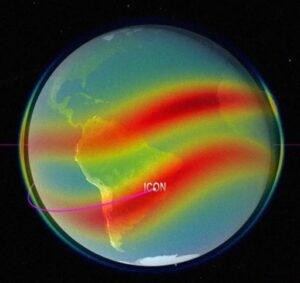
The ionosphere stretches from 50 to 400 miles above the planet and marks the boundary between our planet’s atmosphere and outer space. While it houses most satellites orbiting the Earth, it’s vulnerable to changes in space weather — electromagnetic radiation emitted by the Sun — that can wreak havoc in the zone and mess with communications equipment.
Under some conditions, the layer can become electrically charged. As detected by the Global-scale Observations of the Limb and Disk (GOLD) imaging instrument, plasma bands stretching across the ionosphere can result in formations of unusual X and C shapes.
It’s a baffling “alphabet soup,” as NASA termed the findings in a news release, that could shed light on how space weather can influence our planet’s upper atmosphere and “interfere with radio and GPS signals.”
Charged particles can create dense bands or “crests” around the Earth’s magnetic equator, while low density pockets caused by the setting Sun can result in “low-density pockets” called ‘bubbles,” according to NASA.
Scientists believe that larger disturbances such as solar storms or even massive volcanic eruptions can cause multiple crests to merge and form an “X” shape, as previous GOLD observations have shown.
But now, scientists have spotted these same shapes without any such occasion, during what scientists call “quiet time.”
“Earlier reports of merging were only during geomagnetically disturbed conditions — it is an unexpected feature during geomagnetic quiet conditions,” said University of Colorado research associate Fazlul Laskar, who lead-authored a paper on the discovery earlier this year, in a NASA statement.
Scientists are now wondering if something else could be causing these X shapes to appear.
“The X is odd because it implies that there are far more localized driving factors,” said NASA scientist and ionosphere expert Jeffrey Klenzing. “This is expected during the extreme events, but seeing it during ‘quiet time’ suggests that the lower atmosphere activity is significantly driving the ionospheric structure.”
Apart from X shapes, some bubbles in the ionosphere can also curve into C shapes, which new observations show can appear in close proximity to each other.
In short, there’s a lot still to learn about our planet’s magnetically charged, protective shell.
“The fact that we have very different shapes of bubbles this close together tells us that the dynamics of the atmosphere is more complex than we expected,” Klenzing added.
Read the complete article at https://tinyurl.com/ANS-196-IONOSPHERE.
[ANS thanks nasa.gov for the above information.]
Want to fly the colors on your own grid expedition?
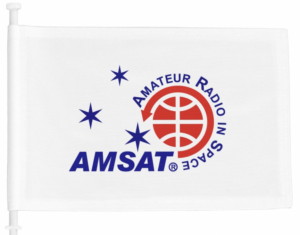
Get your AMSAT car flag and other neat stuff from our Zazzle store!
25% of the purchase price of each product goes towards
Keeping Amateur Radio in Space
https://www.zazzle.com/amsat_gear
Changes to AMSAT-NA TLE Distribution for July 12, 2024Two Line Elements or TLEs, often referred to as Keplerian elements or keps in the amateur community, are the inputs to the SGP4 standard mathematical model of spacecraft orbits used by most amateur tracking programs. Weekly updates are completely adequate for most amateur satellites. TLE bulletin files are updated daily in the first hour of the UTC day. New bulletin files will be posted immediately after reliable elements become available for new amateur satellites. More information may be found at https://www.amsat.org/keplerian-elements-resources/.
This week there are no additions or deletions to the AMSAT TLE distribution.
[ANS thanks Joe Fitzgerald, KM1P, AMSAT Orbital Elements Manager, for the above information.]
ARISS NEWSAmateurs and others around the world may listen in on contacts between amateurs operating in schools and allowing students to interact with astronauts and cosmonauts aboard the International Space Station. The downlink frequency on which to listen is 145.800 MHz worldwide.

Upcoming Contacts
Hokusetsu District Osaka Council Scout Association of Japan, Toyonaka, Japan, direct via JJ3YDM.
The ISS callsign is presently scheduled to be OR4ISS.
The scheduled crewmember is Mike Barrat,t KD5MIJ.
The ARISS mentor is Satoshi Yasuda, 7M3TJZ.
Contact is go for July 18, 2024 at 08:23:52 UTC.
Completed Contacts
Houjoudu Elementary School, Imizu, Japan, direct via JA9YQJ.
The ISS callsign was OR4ISS.
The crewmember was Mike Barratt, KD5MIJ.
The ARISS mentor was Satoshi Yasuda, 7M3TJZ.
Contact was successful on Thursday, July 11, 2024 at 10:48:03 UTC.
Youth On the Air 2024, Mount Saint Vincent University, Halifax, NS, Canada, Telebridge via ZS6JON.
The ISS callsign was NA1SS.
The crewmember was Jeanette Epps. KF5QNU.
The ARISS mentor was Brian Jackson, VE6JBJ.
Contact was successful on Tuesday, July 9, 2024 at 15:06:38 UTC.
The crossband repeater continues to be active (145.990 MHz up {PL 67} & 437.800 MHz down). If any crewmember is so inclined, all they have to do is pick up the microphone, raise the volume up, and talk on the crossband repeater. So give a listen, you just never know.
The packet system is also active (145.825 MHz up & down).
As always, if there is an EVA, a docking, or an undocking; the ARISS radios are turned off as part of the safety protocol.
Note, all times are approximate. It is recommended that you do your own orbital prediction or start listening about 10 minutes before the listed time.
The latest information on the operation mode can be found at https://www.ariss.org/current-status-of-iss-stations.html
The latest list of frequencies in use can be found at https://www.ariss.org/contact-the-iss.html
[ANS thanks Charlie Sufana, AJ9N, one of the ARISS operation team mentors for the above information.]
Upcoming Satellite OperationsNo operation listed at this time.
A growing number of satellite rovers are currently engaged in sharing their grid square activations on https://hams.at. By visiting the website, you gain easy access to comprehensive information about the operators responsible for activating specific grid squares. Additionally, you have the ability to assess the match score between yourself and a particular rover for a given pass, while also being able to identify the upcoming satellite passes that are accessible from your location.
[ANS thanks Ian Parsons, K5ZM, AMSAT Rover Page Manager, and Alex Ners, K6VHF, for the above information.]
AMSAT Ambassador EventsAMSAT Ambassadors provide presentations, demonstrate communicating through amateur satellites, and host information tables at club meetings, hamfests, conventions, maker faires, and other events.
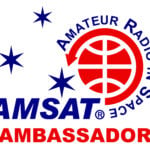
July 13, 2024
Firecracker Hamfest
Salisbury, NC
N7GZT
July 20, 2024
“Moon Day” Frontiers of Flight Museum
Love Field in Dallas, Texas
AMSAT volunteers needed! Contact tschuessler(at) amsat.org for more information.
July 20, 2024
WCARS Hamfest 2024
Waynesville, NC
N4HF
August 3, 2024
2024 KARS / ARRL Idaho State Convention
Post Falls, ID
K7SYS
August 17-18, 2024
Huntsville Hamfest
Huntsville, AL
AMSAT Booth and Forum
N8DEU
August 23-25
2024 Northeast HamXposition and
ARRL New England Division Convention
Marlborough, MA
WD4ASW and W1EME
September 7, 2024
Greater Louisville Hamfest
Shepherdsville, KY
AMSAT Forum and Information Table
W4FCL
October 5, 2024
North Star Radio Convention
Hennepin Technical College (North Campus)
Brooklyn Park, MN.
AMSAT Forum and Information Table
KØJM and ADØHJ
October 25-27, 2004
AMSAT Space Symposium and Annual General Meeting
Double Tree Rocky Point Waterfront Hotel
Tampa Bay, FL
November 2-3, 2024
Stone Mountain Hamfest, ARRL State Convention
Stone Mountain, GA
K4RGK
[ANS thanks the Bo Lowrey, W4FCL, Director – AMSAT Ambassador Program for the above information.]
Satellite Shorts From All Over- Congratulations are in order for Frank Hoonhout, KJ7DZ, for his impressive accomplishment in earning GridMaster Award #66! This esteemed recognition, initiated by Star Comm Group in 2014 and backed by Damon Runion, WA4HFN, and Rick Tillman, WA4NVM, has now been entrusted to AMSAT for the benefit of the entire amateur satellite community. The GridMaster Award celebrates radio amateurs worldwide who achieve two-way communication via amateur satellite with operators in all 488 Maidenhead grids across the contiguous United States of America. For more details on this distinguished award, visit the AMSAT website at https://www.amsat.org/gridmaster/. Frank, your achievement is truly commendable — well done! [ANS thanks Bruce Paige, KK5DO, AMSAT Director of Contests and Awards for the above information.]
- Tom Schuessler is still looking for a few volunteers from the DFW area to assist with the “Moon Day event at the Frontiers of Flight Museum on Saturday, July 20. This is a general public STEAM day with seminars, activities and exhibitors relating to space exploration and astronomy. He will have the CubeSat Simulator, Fox engineering model, explanation of satellite orbits and if available in the time frame, outdoor satellite passes worked. Volunteers get free admission and lunch and a break area. Tom needs to know by probably middle of next week. Drop Tom an email at tschuessler [at] amsat [dot]org. [ANS thanks AMSAT for the above information.]
- Satellite enthusiast David Beumer, WØDHB, became a Silent Key on June 2 after a long battle with a form of Muscular Dystrophy. A ham since his days at Haverford Senior High School in Pennsylvania, from which he graduated in 1969, he was chief engineer of the high school radio station, WHHS. He furthered his education at Stevens Institute of Technology and graduated in 1973 with his degree in Electrical Engineering. Dave started his career in Boston and later moved to San Diego, Calif., where he met Patty. Married in 1980, they moved to the Bay Area in 1984. From there they moved on to Colorado in 1989 for Dave’s job. Dave was employed by Markrevel, Calma, Daisy, Dazix, and VeryBest during his career. He was active on the linear birds and authored the software, FlexSatPC, which is used by many Flex Radio operators for satellite work. [ANS thanks the Beumer family for the above information.]
In addition to regular membership, AMSAT offers membership to:
- Societies (a recognized group, clubs or organization).
- Primary and secondary school students are eligible for membership at one-half the standard yearly rate.
- Post-secondary school students enrolled in at least half time status shall be eligible for the student rate for a maximum of 6 post-secondary years in this status.
- Memberships are available for annual and lifetime terms.
Contact info [at] amsat [dot] org for additional membership information.
73 and remember to help Keep Amateur Radio in Space!
This week’s ANS Editor, Frank Karnauskas, N1UW
f.karnauskas [at] amsat [dot] org
The K7RA Solar Update
New sunspot groups, nine in all, emerged on every day of this reporting week, July 4 to 10. One on July 4, another on July 5, two more on July 6, another each on July 7 and July 8, two more on July 9 and another on July 10.
On July 11, two more sunspot groups emerged, and the total sunspot area expanded by 13 per cent.
Despite the appearance of so many new sunspots, average daily sunspot number...
ARRL on The Weather Channel
ARRL® The National Association for Amateur Radio® joined The Weather Channel on Thursday, July 11, 2024, for a live chat about the value of amateur radio during hurricane season and beyond. ARRL’s Bob Inderbitzen, NQ1R, talked about how radio helps inform the warning process through surface observations relayed through the Hurricane Watch Net and other nets to WX4NHC, the amateur radio station ...
Celebrating Software Defined Radio
At Ham Radio 2024, the International amateur radio exhibition, last week in Friedrichshafen, Germany, the Software Defined Radio Academy (SDRA) celebrated its 10-year anniversary. Founded in 2014, the SDRA has become a new platform for the exchange of knowledge surrounding software defined radio. In the early years, the academy’s lectures were recorded with primitive camera technology, but toda...
Hurricane Beryl Aftermath and Update
Remnants of Hurricane Beryl, now a post-tropical cyclone, were moving northeast as of early Thursday morning with heavy rain and 35 mph winds. The storm is forecast to continue its current direction as it moves through Pennsylvania, upstate New York, northern New England and Canada, moving ENE at 20 mph. Beryl was the fastest and earliest storm of the hurricane season and during its 8-day run t...
2024 ARRL Field Day Log Deadline Approaching
The numbers for ARRL 2024 Field Day continue to grow. As of Thursday, July 11, there were nearly 3,500 entries posted. Remember, the deadline for entries is July 23, 2024. It’s a good idea to check the ARRL Field Day website daily for the latest updates and to make sure your entries are completed. If you see “complete” in the status column, your entries are good. If you see ‘pending documents,’...
ANS-189 AMSAT News Service Weekly Bulletins
In this edition:
* Firefly Delivers New Amateur Satellites to Orbit
* Ariane 6 Maiden Flight With GENESIS-A Module
* Logbook of The World Returns To Service
* LUSAT, Dead or Alive?
* LEGO Bricks Printed out of Space Dust
* Field Day Submissions Now Due
* Changes to AMSAT-NA TLE Distribution
* ARISS News
* Upcoming Satellite Operations
* AMSAT Ambassador Activities
* Satellite Shorts From All Over
The AMSAT News Service bulletins are a free, weekly news and information service of AMSAT, the Radio Amateur Satellite Corporation. ANS publishes news related to Amateur Radio in Space including reports on the activities of a worldwide group of Amateur Radio operators who share an active interest in designing, building, launching and communicating through analog and digital Amateur Radio satellites.
The news feed on http://www.amsat.org publishes news of Amateur Radio in Space as soon as our volunteers can post it.
Please send any amateur satellite news or reports to: ans-editor [at] amsat.org
You can sign up for free e-mail delivery of the AMSAT News Service Bulletins via the ANS List; to join this list see: https://mailman.amsat.org/postorius/lists/ans.amsat.org/
ANS-189 AMSAT News Service Weekly Bulletins
DATE 2024 July 7
Firefly Delivers New Amateur Satellites to OrbitThe Firefly Alpha FLTA005/NASA ELaNa 43 mission, nicknamed “Noise of Summer,” launched successfully at 04:04 UTC on July 4 (Wednesday evening, July 3 in the U.S.) and deployed eight new cube satellites to Low Earth Orbit (LEO). Five of these cubesats carry amateur radio equipment.
The cubesats were placed into a sun-synchronous Earth orbit, meaning that all locations on earth will see high-elevation passes roughly between 8:00 and 10:00 a.m. and between 8:00 and 10:00 p.m. local time daily, with lower elevation passes earlier and later.
Among the newly-deployed satellites, the one of greatest interest to the amateur radio community is MESAT1. Built by the University of Maine, in cooperation with AMSAT, this satellite carries a 30 kHz wide V/U Transponder plus a 1k2 BPSK telemetry downlink. Telemetry downlink 435.800 MHz with transponder downlink 435.810-435.840 MHz, and transponder uplink 145.910-145.940 MHz. Amateurs are encouraged to use AMSAT’s FoxTelem software to collect telemetry.
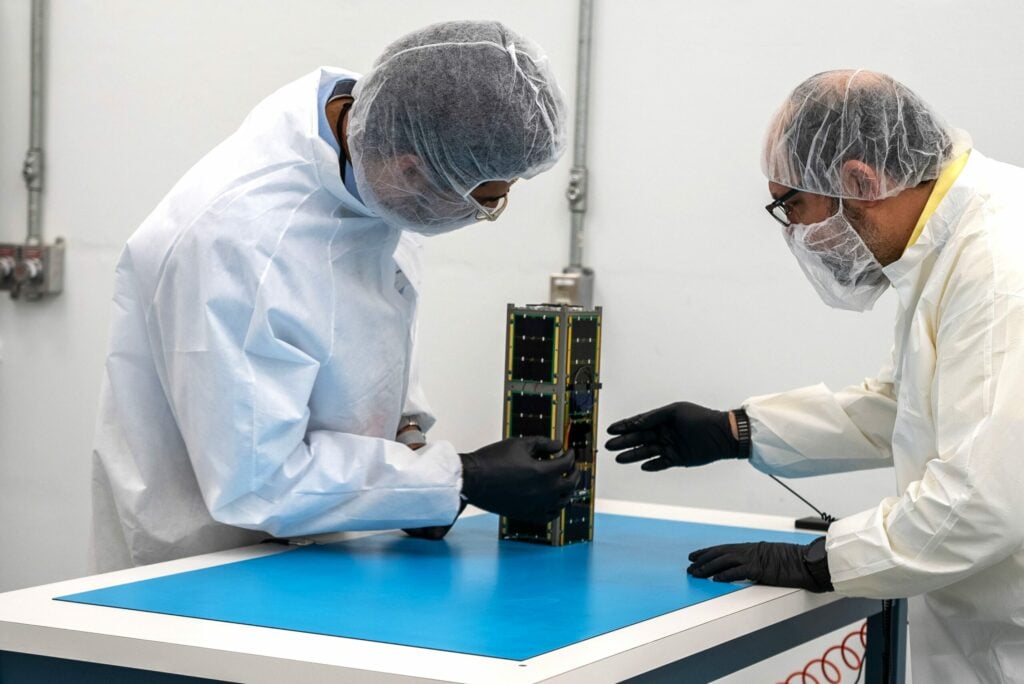
MESAT1 being prepared for integration aboard the Firefly Alpha (Photo credit, University of Maine)
MESAT1 involves three missions designed by high school students in Maine. The science payloads are climate focused and include ALBEDO, IMAGER, and HAB. These will identify urban heat islands, determine concentration of phytoplankton in water bodies, and help predict harmful algal blooms. Four multispectral cameras on board will relay the data down to University of Maine’s ground station for further processing. Amateurs are encouraged to use AMSAT’s FoxTelem software to collect telemetry and assist in these science projects.
Also deployed was CatSat, a technology demonstration of an inflatable antenna for high-speed communications, built by the University of Arizona. CatSat’s deployable antenna consists of a Mylar balloon. The front half of the balloon is transparent, allowing microwaves to pass through. The back half of the balloon is aluminized, creating a reflecting antenna. After reaching low Earth orbit, CatSat’s antenna will deploy and inflate to a diameter of just over one-and-a-half feet CatSat’s demonstration will be to transmit high-definition Earth photos to 10 GHz, X-band ground stations at ~50 megabits per second.
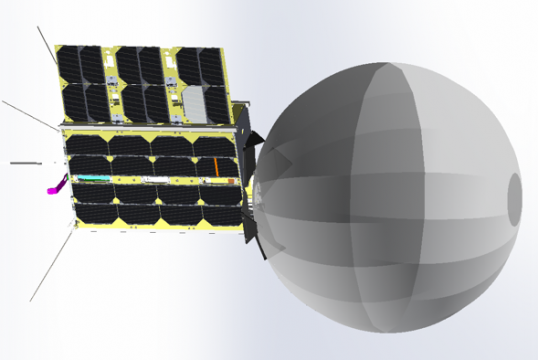
Artist’s rendering of CatSat with 10 GHz balloon antenna deployed. (University of Arizona)
In addition to images, data about the structure of the Earth’s ionosphere will be gathered by listening-in to thousands of beacons from ground-based ham radio stations. CatSat will relay WSPR and FT8 signals from HF. Downlinks on 437.185 MHz and 10470.00 MHz.
Other satellites with IARU-coordinated amateur frequency downlinks include:
Serenity, which uses a 4k8 FM with AX25 downlink on 437.100 MHz. Serenity was built by Teachers in Space, Inc., a 501(c)(3) nonprofit educational organization in North America that stimulates student interest in science, technology, engineering, and mathematics (STEM). They provide teachers with real space science experiences, space flight opportunities, and industry connections.
KUbeSat-1, revives small satellite research at the University of Kansas and starts a new KUbeSat program that will offer space access to student research. The main payload on KUbeSat-1 is the Primary Cosmic Ray Detector which will use a new method to measure the energy and species of primary cosmic rays hitting the Earth. The secondary payload is the High-Altitude Calibration, (HiCalK) that builds on decades of research surrounding Very High Frequency signals generated by cosmic ray interactions with the atmosphere. UHF downlink using 9k6 GMSK. A downlink on 437.085 MHz.
SOC-i (Satellite for Optimal Control and Imaging) is a technology demonstration mission of attitude control technology and a camera that serves as an instrument to demonstrate SOC-i’s pointing abilities. Developed at the University of Washington, SOC-i has a UHF downlink using 4k8 GMSK. downlink 437.125 MHz.
[ANS thanks NASA, Firefly Aerospace, and Spacflight Now for the above information]
The 2024 AMSAT President’s Club coins are here now!
Help Support GOLF and Fox Plus

Join the AMSAT President’s Club today and help
Keep Amateur Radio in Space!
https://www.amsat.org/join-the-amsat-presidents-club/
The maiden flight of the new European launcher, Ariane 6, is scheduled for July 9, 2024, with a launch window of 3:00 p.m. to 7:00 p.m. local time from the European spaceport in French Guiana (July 9 20:00h to July 10 00:00h CEST). Among many other payloads, it carries our (inside YPSAT) GENESIS-A module, attached to the second stage of the launcher. The module will transmit FT8 and live SSTV images in Robot 36 format.
FT8 transmissions are made every 16 seconds, while SSTV’s are every 5 minutes.
The working frequencies are as follows:
Downlink 144.175 MHz FT8 Mode:
– Callsign AO4ARI HO60 if the antenna has been deployed
– Callsign AO4ARI HO61 if the antenna has not been deployed
Downlink 144.550 MHz SSTV Robot 36 mode with live image and Hades text
A carrier with a frequency of 144.550 MHz (same frequency as SSTV) is left between FT8 tones.
This information is compiled in PDF in the following document on our web:
https://www.amsat-ea.org/app/download/13458580/AMSAT+EA+-+GENESIS-A+transmissions+description.pdf
The only thing ESA has given us is the trajectory over the ground while flying over Europe, but we don’t have TLEs or anything that we can semi-automate. It is available on our website:
https://www.amsat-ea.org/s/cc_images/cache_19006006.jpg?t=1720182961
It will be very difficult to receive it but we thank you all if you try and if you spread this information to have all possible operators tuned into FT-8 that day. The module will fall into the sea with the second stage after a few hours.
More information about the flight including timings here:
https://www.esa.int/Enabling_Support/Space_Transportation/Ariane/Ariane_6_launch_how_to_watch_and_what_to_look_out_for
[ANS thanks Félix Páez, EA4GQS, AMSAT EA, for the above information]
Logbook of The World Returns To ServiceEffective 12:00pm ET / 16:00 UTC on July 1, Logbook of The World® (LoTW®) has been to service.
As work progressed on the network, some users encountered LoTW opening briefly during which some 6600 logs were uploaded. The logs were not processed until this weekend as we tested that the interfaces to LoTW were functioning properly.
We are taking steps to help manage what will likely be a huge influx of logs. We are requesting that if you have large uploads, perhaps from contests or from a DXpedition, please wait a week or two before uploading to give LoTW a chance to catch up. We have also implemented a process to reject logs with excessive duplicates. Please do not upload your entire log to “ensure” your contacts are in LoTW as they will be rejected. Lastly, please do not call ARRL Headquarters to report issues you are having with LoTW. You can contact support at LoTW-help@arrl.org.
Through the end of the year, you may experience planned times when LoTW will be unavailable. We have been using this time to evaluate operational and infrastructure improvements we would like to make to LoTW. Those times will be announced.
We appreciate your patience as we worked through the challenges keeping LoTW from returning to service. We know the importance of LoTW to our members, and to the tens of thousands of LoTW users who are not ARRL members. LoTW, just behind QST, is our second most popular ARRL benefit.
[ANS thanks ARRL for the above information]
LUSAT, Dead or Alive?LO-19, co-ordinated by AMSAT Argentina, the LUSAT (named after the LU amateur designation for Argentina) microsatellite was launched on the first ARIANE ASAP flight V35 with SPOT 2, on the 22 January 1990 (01:35:27 GMT) into an 780 km sun-synchronous, 98 degree inclined orbit.
It carried a Digital Store and Forward packet communications transponder similar to AO-16. Downlink was AX.25 at 437.125 MHz SSB 1200 bps RC-BPSK. It is box shaped with dimensions of 213 × 230 × 230 mm, with four solar panels and weighs 13.76 kg.
Long past its expected useful life, in recent years LUSAT has only been transmitting an unmodulated carrier signal.
On June 29, Gustavo Carpignano, LW2DTZ, reported that recent observers had failed to detect the carrier. Gustavo declared LO-19 dead.
However, on July 1, Nico Janssen, PAØDLO, reported receiving the carrier, but at a signal strength much weaker than over previous years. Nico suggested that, perhaps, the onboard power amplifier has failed.
Well-equipped ground stations may wish to give a listen to test what they can hear.
[ANS thanks Gustavo Carpignano, LW2DTZ, Nico Janssen, PAØDLO, and Gunter’s Space Page, for the above information]
Need new satellite antennas?
Purchase M2 LEO-Packs from the AMSAT Store.

When you purchase through AMSAT, a portion of the proceeds goes towards
Keeping Amateur Radio in Space.
https://amsat.org/product-category/hardware/
There have been many proposals for building structures on the Moon out of lunar regolith. But here’s an idea sure to resonate with creators, mechanical tinkerers, model builders and the kid inside us all.
What about using actual LEGO bricks?
Researchers ground up a 4.5-billion-year-old meteorite and used the dust to 3D print LEGO-style space bricks. They actually click together like the plastic variety, with so far only one downside: they only come in one color, grey.
Universe Today
Want to see some of these lunar LEGOs? LEGO will showcase the space bricks at some of its stores.
Creating building materials on the Moon or Mars from the material on hand means construction materials don’t have to be transported from Earth. This would be a huge savings in launch costs because less weight would have to be boosted from Earth.
A group of scientists from ESA (European Space Agency) were inspired by LEGO bricks, and with the advances in 3D printing, had the idea to print space bricks and test how they would work for construction.
The only problem was that except for the Moon rocks brought back by the Apollo astronauts – which are highly guarded for scientific study only — there’s not any lunar regolith available on Earth to experiment with.
But meteorite dust is a close cousin to lunar regolith. The ESA team was able to get a meteorite that was discovered in Northwest Africa in 2000 and is about 4.5 billion years old. It is made of metal grains and chondrules, similar to Moon dust.
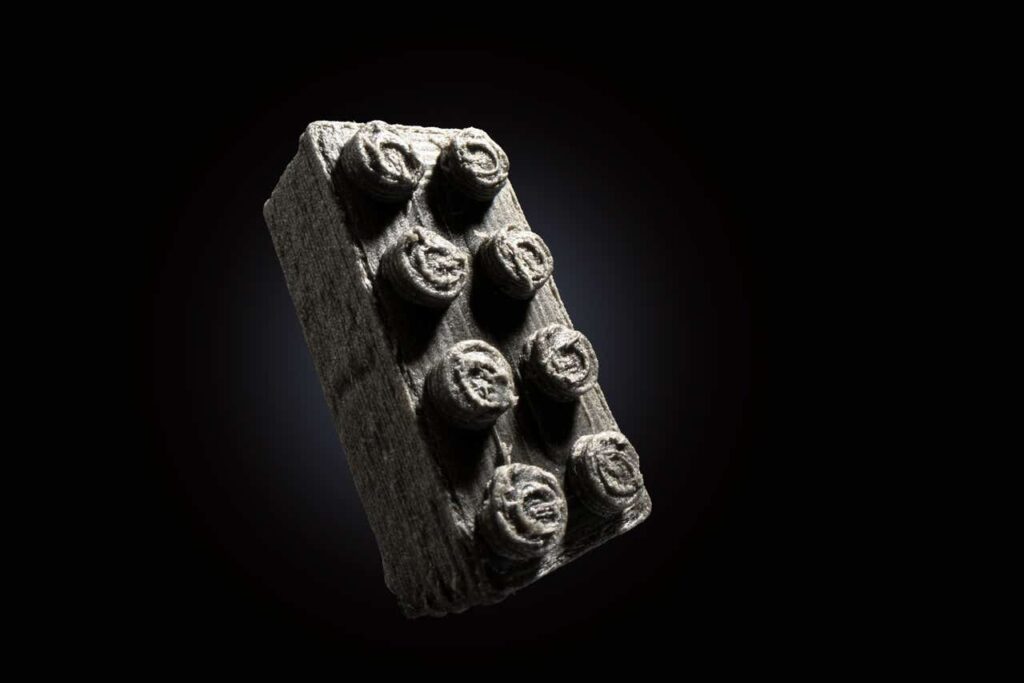
Inspired by LEGO, ESA scientists have used dust from a meteorite to 3D-print LEGO-style ‘space bricks’
to test out construction ideas for a future Moon base. Credit: The LEGO Group
They mixed the meteorite dust with a some other things, like a polymer called polylactide and regolith simulant and 3D printed bricks that mimic and behave just like LEGO bricks. While they aren’t smooth like regular LEGO bricks, ESA said the space bricks gave ESA’s space engineers the flexibility to build and test a variety of structures using this new material.
“It’s no secret that real-world scientists and engineers sometimes try out ideas with LEGO bricks,” said Emmet Fletcher, Head of ESA’s Branding and Partnerships Office. “ESA’s space bricks are a great way to inspire young people and show them how play and the power of the imagination have an important role in space science, too.”
“Nobody has built a structure on the Moon, so it was great to have the flexibility to try out all kinds of designs and building techniques with our space bricks,” said . ESA Science Officer Aidan Cowley. “It was both fun and useful in scientifically understanding the boundaries of these techniques.”
For a list of where the lunar LEGOs will be on display worldwide, see https://www.universetoday.com/167675/lego-bricks-printed-out-of-space-dust/#more-167675
The LEGO website has additional details at https://www.lego.com/en-us/aboutus/news/2024/june/lego-bricks-scientists-build-astronaut-shelters-on-the-moon
Hopefully the lunar LEGOs will inspire both children and adults about space and to encourage them to build their own LEGO Moon bases.
[ANS thanks Universe Today for the above information]
Field Day Submissions Now DueField Day is behind us and it is time to tally your contacts and submit the for AMSAT Field Day.
The Satellite Summary Sheet should be used for submission of the AMSAT Field Day competition and be received by KK5DO (e-mail) by 11:59 P.M. CDT, Monday, July 23, 2024. This year, we are using the same due date as the ARRL. The only method for submitting your log is via e-mail to kk5do@amsat.org or kk5do@arrl.net. I have not had a mail-in entry in a very long time.
If you need to download a summary sheet, it can be found at https://www.amsat.org/field-day/
or directly from my website https://www.amsatnet.com/2024fd.docx
[ANS thanks Bruce Paige, KK5DO, AMSAT Director Contests and Awards, for the above information]
Want to fly the colors on your own grid expedition?
Get your AMSAT car flag and other neat stuff from our Zazzle store!

25% of the purchase price of each product goes towards
Keeping Amateur Radio in Space
https://www.zazzle.com/amsat_gear
Two Line Elements or TLEs, often referred to as Keplerian elements or keps in the amateur community, are the inputs to the SGP4 standard mathematical model of spacecraft orbits used by most amateur tracking programs. Weekly updates are completely adequate for most amateur satellites. TLE bulletin files are updated daily in the first hour of the UTC day. New bulletin files will be posted immediately after reliable elements become available for new amateur satellites. More information may be found at https://www.amsat.org/keplerian-elements-resources/.
The following satellites from last week’s Firefly Alpha FLTA005/NASA ELaNa 43 launch have been added. They are listed as OBJECT A-H, with the exception of object G which is likely MESAT1. As is the case with most cubesat launches, it will take a while to figure out which object is which.
OBJECT A 60203
OBJECT B 60204
OBJECT C 60205
OBJECT D 60206
OBJECT E 60207
OBJECT F 60208
MESAT1 60209
OBJECT H 60210
OBJECT J 60211
OBJECT K 60212
[ANS thanks AMSAT Orbital Elements page for the above information]
ARISS NEWSAmateurs and others around the world may listen in on contacts between amateurs operating in schools and allowing students to interact with astronauts and cosmonauts aboard the International Space Station. The downlink frequency on which to listen is 145.800 MHz worldwide.
UPCOMING CONTACTS:
Youth On the Air 2024, Mount Saint Vincent University, NS, Canada, Telebridge via ZS6JON
The ISS callsign is presently scheduled to be NA1SS
The scheduled crewmember is Jeanette Epps, KF5QNU
The ARISS mentor is VE3TBD
Contact is go for: Tue 2024-07-09 15:06:38 UTC 65 degrees maximum elevation
Houjoudu Elementary School, Imizu, Japan, direct via JA9YQJ
The ISS callsign is presently scheduled to be OR4ISS
The scheduled crewmember is Mike Barratt, KD5MIJ
The ARISS mentor is 7M3TJZ
Contact is go for: Thu 2024-07-11 10:48:03 UTC 83 degrees
The crossband repeater continues to be active (145.990 MHz up {PL 67} & 437.800 MHz down). If any crewmember is so inclined, all they have to do is pick up the microphone, raise the volume up, and talk on the crossband repeater. So give a listen, you just never know.
The packet system is also active (145.825 MHz up & down). HamTV (2.395 GHz) and SSTV (145.80 MHz) are both stowed.
As always, if there is an EVA, a docking, or an undocking; the ARISS radios are turned off as part of the safety protocol.
Note, all times are approximate. It is recommended that you do your own orbital prediction or start listening about 10 minutes before the listed time.
The latest information on the operation mode can be found at https://www.ariss.org/current-status-of-iss-stations.html
The latest list of frequencies in use can be found at https://www.ariss.org/contact-the-iss.html
[ANS thanks Charlie Sufana, AJ9N, one of the ARISS operation team mentors for the above information]
Upcoming Satellite OperationsNDØC and family will be on another family camping vacation from 24 June thru 7 July, this time through Wisconsin to Michigan and back thru Illinois and Iowa. No super rare grids but several that may be needed by many. The grids and passes will depend on where/when we happen to be while on the road or camping. This will be all LEO sats: FM & SSB. As always, they will try for EU passes on RS-44 when possible. Randy is looking forward to pushing past the 100 grids-roved milestone.
A growing number of satellite rovers are currently engaged in sharing their grid square activations on https://hams.at. By visiting the website, you gain easy access to comprehensive information about the operators responsible for activating specific grid squares. Additionally, you have the ability to assess the match score between yourself and a particular rover for a given pass, while also being able to identify the upcoming satellite passes that are accessible from your location.
[ANS thanks Ian Parsons, K5ZM, AMSAT rover page manager, for the above information]
AMSAT Ambassador ActivitiesAMSAT Ambassadors provide presentations, demonstrate communicating through amateur satellites, and host information tables at club meetings, hamfests, conventions, maker faires, and other events.
July 20, 2024
“Moon Day” Frontiers of Flight Museum
Love Field in Dallas, Texas
AMSAT volunteers needed! Contact tschuessler(at) amsat.org for more information.
August 17-18, 2024
Huntsville Hamfest
Huntsville, AL
AMSAT Booth and Forum
N8DEU and W4FCL
September 7, 2024
Greater Louisville Hamfest
Shepherdsville, KY
AMSAT Forum and Information Table
W4FCL
October 5, 2024
Central Kentucky Hamfest
Lexington, KY
AMSAT and Educational Satellites Forum and Information Table
AI4SR and W4FCL
October 5, 2024
North Star Radio Convention
Hennepin Technical College (North Campus)
Brooklyn Park, Minn.
AMSAT Forum and Information Table
KØJM and ADØHJ
AMSAT Ambassador Clint Bradford, K6LCS, says,
“Think a 75-minute presentation on “working the easy satellites” would be appropriate for your club or event? Let me know by emailing me at k6lcsclint (at) gmail (dot) com or calling me at 909-999-SATS (7287)!”
Clint has NEVER given the exact same show twice: EACH of the 150+ presentations so far has been customized/tailored to their audiences.
[ANS thanks the AMSAT Events page for the above information]
Satellite Shorts From All Over+ What GOES up … NOAA’s latest Geostationary Operational Environmental Satellite, GOES-U, launched on the first Falcon Heavy of the year on June 25 from Launch Complex 39A at Kennedy Space Center. The mission, the last of the GOES-R series of geostationary weather satellites, continuously monitors weather systems over the Western Hemisphere. Assuming that next week’s planned burn to lift the satellite to geosynchronous orbit is successful, this satellite will be re-designated as GOES-19 and will, in coming months, take over the GOES-East duties from the aging GOES-16. (See ANS 182 last week for more details.)
+ Musk come down … Elon Musk’s SpaceX has won a contract valued at up to $843 million to build a vehicle capable of safely deorbiting the International Space Station once the station is decommissioned in 2030. While many people have suggested raising the ISS’s orbit and turning it into a museum, the amount of fuel needed to move the approximately 420-ton station to a high enough orbit to remain stable for long durations is prohibitive.
+ Blow up … Russian Resurs-P1, an almost-six-ton defunct Earth observation satellite that stopped orbit maintenance in 2017 but continued operations until 2022, unexpectedly exploded last week into hundreds of fragments. Expected to reenter later this year, Resurs-P1 was orbiting at ~350 km, close enough to the ISS’s orbital altitude that the event forced ISS astronauts into shelter for an hour while debris was tracked.
+ Or go up, come down, and blow up (unexpectedly) … during a static fire test of the first stage of China’s close-to-finished Tianlong-3 rocket, the hold-down hardware failed to do its singular job: hold down the rocket. Moments after ignition, the rocket shot 1.5 km into the sky above the city of Gongyi, China. With no guidance system, gravity took over, resulting in a massive fireball on impact. Very fortunately, there were no casualties as the rocket mostly went straight up and straight back down.
(ANS thanks The Orbital Index for all of the above items.)
Join AMSAT today at https://launch.amsat.org/
In addition to regular membership, AMSAT offers membership to:
* Societies (a recognized group, clubs or organization).
* Primary and secondary school students are eligible for membership at one-half the standard yearly rate.
* Post-secondary school students enrolled in at least half time status shall be eligible for the student rate for a maximum of 6 post-secondary years in this status.
* Memberships are available for annual and lifetime terms.
Contact info [at] amsat.org for additional membership information.
73 and remember to help Keep Amateur Radio in Space!
This week’s ANS Editor, Mark Johns, KØJM
k0jm [at] amsat.org
The K7RA Solar Update
Solar activity increased this week, with average daily sunspot numbers rising from 149.6 to 181.6. For some reason average daily solar flux decreased from 178 to 175.
Seven new sunspot groups emerged this week, one on June 27, two on June 28, three on June 29, and one more on July 3.
Average daily planetary index rose from 10.3 to 15.6 while average middle latitude A index rose from 10.1 to 11....
New ARRL Section Managers
Nominations for 2024 ARRL Section Managers have been made. All nominees listed ran unopposed and returned their nomination forms by the June 7, 2024, deadline. They have been notified by mail and elected for new terms beginning October 1, 2024.
Connecticut:
Douglas Sharafanowich, WA1SFH (new)
Idaho:
Dan Marler, K7REX
Minnesota:
Bill Mitchell, AEØEENorth Dakota:
Ralph Fettig, NØRDFOhio:
Thomas Sly,...
ARRL Systems Service Disruption
Updated 07/03/2024
The ARRL Volunteer Examiner Coordinator Program continues to operate during the systems service disruption.
ARRL Volunteer Examiners (VEs) should continue to submit exam registrations and material requests. While we are unable to post new or revised exam session dates and details to the website, we can ship out exam materials. Please remember that most exam materials are avail...
ARRL Logbook of The World Returns to Service
ARRL Logbook of The World® (LoTW®) returned to service July 1, 2024. It had been offline as part of a systems service disruption.
As work progressed on the network, some users encountered LoTW opening briefly during which some 6600 logs were uploaded. The logs were not processed until this weekend as we tested that the interfaces to LoTW were functioning properly.
We are taking steps to help mana...